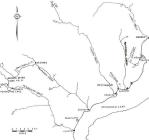4
What makes the climate of the Okanagan Valley?Lying in the rain shadow of the Coast and Cascade mountains, the Okanagan Valley has a dry climate. Precipitation increases from south to north in the valley, with an everage of 11 inches of rain and 3 feet of snow falling each year in Peachland. The temperature during July and August averages around 30.4 C and during December and January the average is -5.7 C.
Climate change is taking place in the Okanagan Valley. The climate became warmer and wetter in the last century; an average of 27 more frost-free days occurred in 1993 than were recorded in 1907. With more frost-free days, the growing season is longer and requires more irrigation water. More precipitation also falls as rain rather than snow, so the timing changes of water inputs to streams.
Streams in the Okanagan are fed mainly by the snow melting in spring that enters the streams. This high water flow, called the spring freshet contributes two-thirds of the annual stream flow. By July, the freshet period ends and the water flow remains low for the summer, autumn, and winter. This means that water flow in creeks is low during the peak irrigation months and during the peak migration and spawning periods for fish.
Scientists have noticed changes in streams that are probably related to climate change: an earlier start to the spring freshet, lower water flow in autumn, and higher water flow in early winter. They predict that these trends will continue over the next 80 years.
